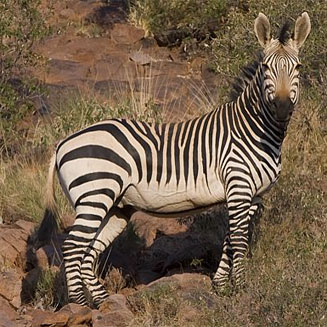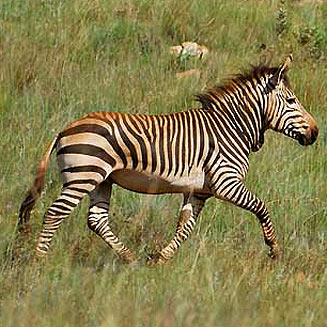|
Equus zebra
hartmannae (Hartmann's mountain zebra)
Hartmann zebra [English]; Hartmann se bergsebra, Hartmannbergkwagga,
Damaralandse bergkwagga [Afrikaans]; Hartmann's Bergzebra [German]; zèbre de
montagne [French]; iduba Ie-Hartmann [isiNdebele]; idauwa, iqwarhashe [isiXhosa]; izebra laseqintabeni [isiZulu]; pitse ya naga [Sepedi]; qwaha ya thaba [Sesotho]; lidvuba [siSwati]; mangwa [Xitsonga]; mbidithavha [Tshivenda]; !Hom !goreb [Nama] [Damara]; ngorlo, hambarandu [Herero]; daou [Khoikhoi]; dou [San]
Life
>
Eukaryotes >
Opisthokonta >
Metazoa (animals) > Bilateria > Deuterostomia >
Chordata > Craniata > Vertebrata (vertebrates) >
Gnathostomata (jawed vertebrates) > Teleostomi (teleost
fish) > Osteichthyes (bony fish) > Class:
Sarcopterygii (lobe-finned fish) > Stegocephalia
(terrestrial vertebrates) > Reptiliomorpha > Amniota >
Synapsida (mammal-like reptiles) > Therapsida > Theriodontia
> Cynodontia > Mammalia (mammals)
> Placentalia (placental mammals) >
Laurasiatheria > Ferungulata > Paraxonia > Perissodactyla (odd-toed
ungulates) > Family: Equidae (horses, zebras, donkeys)
 |
 |
|
Equus zebra
hartmannae (Hartmann's mountain zebra), Tswalu Kalahari Reserve, South
Africa. [photo Trevor
Hardaker ©] |
Hartmann's mountain zebra. [photo
Callie de Wet ©] |
Limited to the montane escarpment of Namibia, and
extending marginally into south-western Angola.It is larger than the
Cape mountain zebra, which is the other subspecies of Mountain
zebra. Mountain zebras are best distinguished from Plains zebra by
the fact that the stripes do not extend under the belly.
Description
The Hartmann’s mountain zebra and Cape mountain
zebra are the only two mountain zebra subspecies. Horse-like in
appearance the Hartmann’s Mountain zebra is larger than the Cape
Mountain zebra and smaller than the plains zebra. Although they
resemble each other there are some differences. Typically the ground
colour of the sleek coat is white with black stripes. The black
stripes on the body are narrower than those on the rump and do not
continue onto the belly, stopping abruptly on the lower side of the
flanks. The underside is white. There is no shadow striping on the
body. Diagnostic of the species is a grid-iron type pattern over the
top of the tail formed by a series of transverse stripes. There is a
narrow black stripe that runs along the mid line of the tail to the
dark brown of black whisk. The stripes on the head are the
narrowest. An erect mane runs along the top of the neck from ears to
above the shoulders. The muzzle is black with russet-brown hair up
the face over the nose area. The hooves are narrow and compact in
shape with very hard ventral surface, this is an adaptation to the
hard and rocky terrain. A dewlap is present under the throat, and is
a diagnostic characteristic of the species.
Several theories have been proposed to try to
explain the conspicuous black and white striping characteristic of
the zebra coat. Earlier suggestions that the colouration functions
as camouflage, confuses predators or deters flies have been
discredited. Research suggests that the patterning may have a social
function, as zebras appear to respond to its visual stimulation. It
is thought that it stimulates mutual grooming in the preferred body
areas, this will in turn facilitate bonding within groups.
Size
Shoulder height 1.5 m; weight 250-350 kg.
Dental Formula
I C C P P M M = =

Distribution and habitat
The montane escarpment of Namibia, and
extending marginally into south-western Angola. It is closely
confined to mountainous areas that provide suitable grasses for
grazing and sufficient drinking water.
General behaviour
Mountain zebra are non- territorial and
gregarious, living in breeding herds that consist of a breeding
stallion with 3-4 mares and their foals. . Bachelor herds have a
clear social hierarchy and may be joined by non-breeding fillies for
brief periods. These zebra are diurnal with their most active
periods being after dawn , later in the morning and then late
afternoon. In the dry seasons Hartmann’s may collect in loose
associations of up to 40 animals. When threatened the dominant mare
in the herd will lead the others away to safety, the stallion
remains at the rear to defend the herd if necessary. Vocalizations
include a high-pitched alarm call from the stallion and a protracted
squeal by a bachelor stallion when challenged by the herd stallion.
Food
It is primarily a grazer but will browse when
the quality of the grass supply declines.
Reproduction
The gestation period is about 360 days - i.e.
close on a year. Foals are born throughout the year, but foaling
peaks in summer during renewed vegetation growth. A single foal is
born and is able to keep up with the herd within an hour of birth.
It stays in close association with its mother for the first weeks of
its life. Mares with new-born foals are aggressive towards other
members in the herd and actively discourage contact between the foal
and others. The foal remains with its mother until after the next
sibling is born and then leaves the maternal herd. Fillies leave
after about 19 months and colts after 2 years, they then join up
with the bachelor herds. Fillies remain associated with a
non-breeding bachelor herd for about 9 months and then join a
breeding group herd, while colts remain with the bachelor group for
long, an average of 2.5 years.
Life span
30 years (captivity)
Conservation
The dramatic colouration of zebra coats makes
the skins desirable to hunters and they compete with domestic stock
for grazing in certain areas. There is very little evidence of
hybridization between the two subspecies of mountain zebra, although
this would be possible the natural distributions are geographically
distinct and distant. However, with the translocation of animals by
man this is regarded as a major genetic threat and all possible
actions should be taken to prevent it in the future.
The Mountain zebra (both subspecies) is
classified as Vulnerable in the IUCN Red List of Threatened Species
(see link below).
Links
Text by Denise Hamerton |
